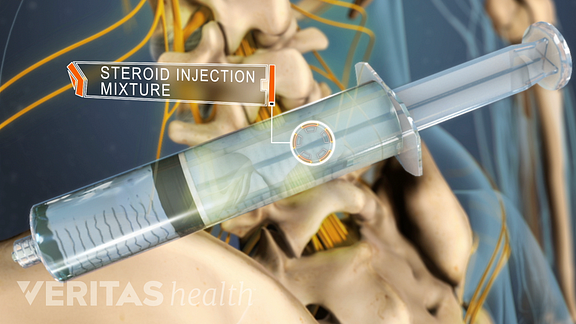Injections are a nonsurgical treatment option for acute or chronic neck or back pain. They are considered to treat spinal pain after other nonsurgical measures such as medications and/or physical therapy have been tried, but before surgery is considered. Injections can provide pain relief and help determine the source of a patient’s pain.
Epidural steroid injections deposit medication, typically steroids, in the epidural space of the spine to help control inflammation and pain. Watch: Epidural Steroid Injections for Back Pain and Leg Pain Video
How Injections Relieve Pain
Injections can deliver medication directly to the anatomic location that generates pain, which may provide more neck or back pain relief than oral medications.
See Medications for Back Pain and Neck Pain
Injections for neck and/or back pain may work in one of the following ways:
- Deliver a steroid and/or other pain-relieving medication into the area that is the source of pain to reduce inflammation and numb the pain.
- Create a heat lesion (radiofrequency ablation) on a pain-transmitting nerve to prevent it from sending pain signals to the brain.
Injections can also be used to help determine the anatomic structure in the spine that could potentially be the source of pain, such as a herniated disc or a compressed nerve.
See Spine Anatomy Overview Video
Diagnostic Injections for the Spine
Diagnostic injections typically deliver an anesthetic medication near the suspected source of pain, such as a facet joint or a spinal nerve. If temporary pain relief is achieved until the effect of the local anesthetic wears off, it can be inferred that the specific region is the source of the pain.
See Facet Joint Disorders and Back Pain
When considered in conjunction with a patient’s history, physical exam, and imaging studies, diagnostic injections can help guide further treatment.
See Diagnostic Processes for Neck and Back Pain
In This Article:
Common Injections for Neck and Back Pain Relief
Therapeutic injections are usually used to treat neck or back pain stemming from a facet joint, spinal nerve, and/or an intervertebral disc.
Commonly administered injections for neck and back pain are:
- Epidural injections—deposit the medication, typically steroids, in the epidural space of the spine.
See Lumbar Epidural Steroid Injections for Low Back Pain and Sciatica
- Selective nerve root block injections—target a specific spinal nerve and deposit medication around the nerve at the point where it exits the intervertebral foramen (bony opening between adjacent vertebrae).
- Facet joint injections—treat pain stemming from a specific facet joint.
- Medial branch blocks—deposit medication around the medial branches of spinal nerves. The medial branch is a nerve that sends pain signals to the brain from an arthritic facet joint. An injection directed around the medial branch can relieve neck pain and also be used to treat headaches stemming from the neck.
- Sacroiliac (SI) joint injections—treat pain originating from the SI joint, which connects the spine to the pelvis.
- Radiofrequency ablation (RFA)—treats pain by lesioning a medial or lateral branch nerve of the facet or SI joint.
See Radiofrequency Ablation (RFA) for Facet and Sacroiliac Joint Pain
Pain relief from these injections may occur within a few hours or may take 1 to 2 weeks to take effect, such as in RFA. Initially, there may be some restriction of physical activity, following which, routine activities may be resumed. These treatment injections are commonly used in combination with physical therapy to strengthen the surrounding muscles and restore mobility.
See Physical Therapy for Low Back Pain Relief and Physical Therapy for Neck Pain Relief
Other types of injections may also be considered depending on the condition being treated.
Less Common Injections for Neck and Back Pain Relief
Less commonly, pain from other joints or nerves in the spine may be treated with injections. A few examples include:
- Stellate ganglion block—treats head, neck, and/or upper limb pain stemming from the stellate or cervicothoracic ganglion (a group of nerves) in the lower cervical spine.
Watch: Cervical Spine Anatomy Video
- Costovertebral joint injections—treats upper back and rib pain stemming from the joint between the vertebral body and the rib in the thoracic spine.
- Costotransverse joint injections—treats upper back and rib pain stemming from the joint between the transverse process of the vertebra and the rib in the thoracic spine.
See Costotransverse and Costovertebral Joint Injections
Spinal injection procedures may be performed at a doctor’s office, surgical center, or hospital. Post-procedure monitoring may last for 15 minutes to an hour before the patient is cleared to go home.
The Role of Medical Imaging in Spinal Injections
Spinal injections are almost always performed under the guidance of fluoroscopy (live x-ray) or ultrasound. A contrast dye is injected into the tissues to make sure the needle is accurately placed at the suspected site of pain. Medical imaging also helps prevent injury and further complications that may be caused by injecting into adjacent structures such as blood vessels.
Watch: Types of Spinal Injections Video
In general, these injections carry a small risk of false-positive/negative responses based on the technique used and/or amount of medication given.
Therapeutic injections using fluoroscopic guidance may not be given during pregnancy or when an infection or bleeding disorder is present.



